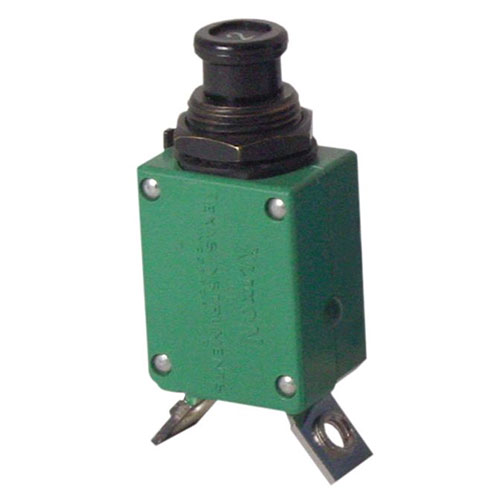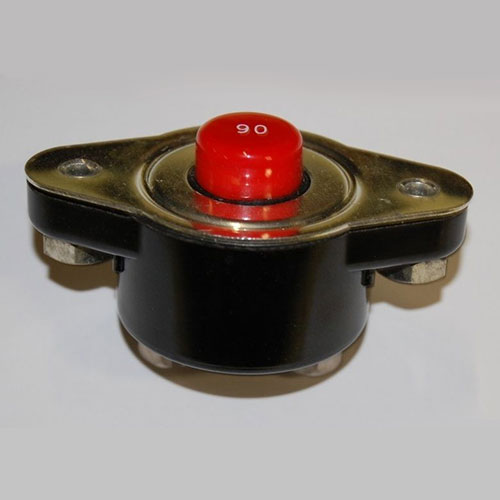Circuit protection is essential for ensuring the safe, reliable, and efficient operation of electrical systems. Various types of circuit breakers are designed to address specific system requirements, such as load characteristics and operating environments. In today’s post, we’ll explore thermal circuit breakers, how they work, their different types, and their applications in industrial, military, defense, and aerospace settings.
How Do Thermal Circuit Breakers Work?
Thermal circuit breakers are a type of circuit breaker that differs from other types primarily in their operating mechanism. Thermal circuit breakers use a bimetallic strip rather than electronic components to trip the breaker and interrupt the current. The bimetallic strips are comprised of two different metals with different thermal expansion rates that bend and trip the circuit breaker when exposed to excessive current or heat, making these strips the main components for overload protection. Thermal breakers are often slower to respond due to this process, which makes them well-suited for gradual overloads.
Types of Thermal Circuit Breakers
Several types of thermal circuit breakers are available, distinguished mainly by their reset mechanism. Therefore, they are best suited for systems or applications focused on overload protection, where instantaneous tripping for short-circuit protection is less critical.
Type I (Automatic Reset)
A Type I thermal circuit breaker automatically resets or cycles after tripping from an overload, which causes the thermal mechanism to bend and open the circuit. The resetting occurs once the temperature cools, automatically closing the circuit. Type I thermal circuit breakers work well in low-voltage applications where automatic resetting is safe, such as auxiliary systems like cooling fans, small motors, and pumps in non-critical settings. They are not designed for long-term cycling, and installation downstream of a main fuse, manual reset breaker, or momentary switch is best.
Type II (Modified Reset)
This type is similar to Type I, except it has a modified or delayed reset function, which requires specific conditions before resetting occurs, i.e., it is non-cycling. It requires a minimum voltage/current to maintain an open circuit and resets only when the power is turned off. Therefore, Type II breakers suit systems that need more control over when a breaker resets.
Type III (Manual Reset)
The Type III thermal circuit breaker is non-cycling and requires manual resetting after an overload occurs and the temperature cools. These breakers include a button, lever, or other external reset device to engage and reset manually. The Type III circuit breaker works best in applications that require a safe diagnosis of a circuit fault before resetting, such as high-powered equipment or machinery.
Type III* (Manual Reset - Push to Trip)
The Type III* thermal circuit breaker is ideal in applications where users need to manually open the circuit and trip the system, which is ideal for maintenance and troubleshooting. Therefore, the breaker requires manual resetting to reclose the circuit after the circuit is manually tripped to open.
Type III* (Manual Reset - Switchable)
This Type III* thermal circuit breaker functions like Type III* (Manual Reset - Push to Trip), except it includes a manual ON/OFF switch for easier switching between the two. It also requires a manual reset, but the switchable design makes resetting much easier to manage. Therefore, this type is ideal for more advanced applications or systems requiring manual resetting and convenient ON/OFF switching.
Applications of Thermal Circuit Breakers


Thermal circuit breakers are integral to many systems and applications within industrial, aerospace, military, defense, and renewable energy electronics where sustained overload protection is essential.
Industrial Thermal Circuit Breakers
Numerous industrial applications rely on thermal overcurrent circuit breakers to protect essential systems from overload conditions, including control panels, automation systems, power supplies, distribution systems, marine applications, trucks and heavy equipment. For example, thermal circuit breakers are instrumental in protecting transformers, switchgear, and distribution panels from prolonged overloads, safeguarding them from overheating or component damage.
Thermal Circuit Breakers in Aerospace
In an industry where safety and reliability are paramount, Type III and Type III* breakers help ensure precise control over circuit protection, allowing manual resets and power management in aerospace systems. Type III* (manual reset - push to trip) thermal circuit breakers are commonly used in safety-critical systems, like emergency lighting, avionics, and flight control electronics, where they facilitate safety testing during pre-flight checks.


Thermal Circuit Breakers in Military & Defense
The military and defense industry relies on thermal circuit breakers for their compact design, reliability, and ability to perform under extreme conditions. In command and control systems, for example, thermal circuit breakers help prevent critical systems from overheating, protecting servers and operational electronics in military command centers and mobile units without the need for continuous monitoring.


Thermal Circuit Breakers in Renewable Energy Systems
Renewable energy systems often operate in harsh environments with fluctuating loads, making robust circuit protection essential for protecting sensitive components. For example, Type III* (manual reset - switchable) thermal circuit breakers are ideal for hydropower installations where manual rest capabilities for control panels and auxiliary systems help ensure reliable protection in remote or unmanned environments.
CDM Breakers vs. Thermal Circuit Breakers
CDMs ( Circuit Disconnect Modules) and thermal circuit breakers both offer fault protection to electrical circuits, but they differ in design, operation, and applications. CDM breakers rely on solid-state electronics, including components like microcontrollers or logic circuits, to monitor and control current flow. These breakers trip based on predefined conditions programmed into their circuitry, offering precise and adaptable protection for complex systems. In contrast, thermal circuit breakers function purely on mechanical and thermal principles, using a bimetallic strip or other thermal-sensitive elements to detect overloads. Additionally, CDM breakers respond much faster than the heat-dependent, slower-acting thermal circuit breakers.
As a result, CDM breakers are ideal for applications requiring programmable, real-time adaptability, like advanced automation systems. Thermal circuit breakers, on the other hand, are better suited for simpler systems that need reliable and cost-effective protection without complex electronics.
Buy Reliable Thermal Circuit Breakers at Peerless Electronics
When reliability, durability, and simplicity are paramount for consistent overload protection in industrial, military, defense, and aerospace electrical applications and systems, thermal circuit breakers are an optimal solution. They provide reliable protection without the need for complex programming, making them ideal for harsh environments and systems requiring long-term dependability with minimal maintenance, particularly those that are remote or unmanned.
As a fully authorized source for today’s leading thermal circuit breaker manufacturers, Peerless Electronics has your needs fully covered. Shop our website to find your optimal solution, or contact us with questions or to request a quote.
























